Ballarat
| Ballarat Victoria |
|||||||
 Top left: Queen Victoria statue in front of Ballarat Town Hall, top right: Ballarat railway station, centre: CBD panorama from Black Hill lookout, centre left: cnr Lydiard and Sturt Streets and Craigs Hotel, centre right: Arch of Victory Alfredton, bottom left: Former Post Office and Lydiard Street bottom right: Sovereign Hill. |
|||||||
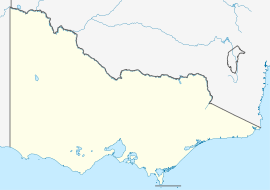 Ballarat
|
|||||||
| Population: | 78,221 (2006 census)[1] (20th) | ||||||
| • Density: | 1220/km² (3,159.8/sq mi) | ||||||
| Established: | 1838 | ||||||
| Postcode: | 3350 | ||||||
| Elevation: | 435 m (1,427 ft) AHD | ||||||
| Area: | 740 km² (285.7 sq mi) | ||||||
| Time zone:
• Summer (DST) |
AEST (UTC+10)
AEDT (UTC+11) |
||||||
| Location: | |||||||
| LGA: | City of Ballarat | ||||||
| State District: | Ballarat East, Ballarat West | ||||||
| Federal Division: | Ballarat | ||||||
|
|||||||
Ballarat (pronounced /ˈbæləræt/)[2] is a city in the state of Victoria, Australia, approximately 105 kilometres (65 mi) north-west of the state capital Melbourne. It is the largest inland centre and the third most populous city in the state. The estimated urban area population is 94,088.[3] It is the administrative centre for the City of Ballarat, which encompasses both the urban area and outlying towns spanning an area of 740 square kilometres (290 sq mi). Inhabitants of Ballarat are known as Ballaratians.[4]
It was named by Scottish settler Archibald Yuille who established the sheep run called Ballaarat in 1837[5] with the name derived from local Wathaurong Aboriginal words for the area, balla arat, thought to mean 'resting place'.
Ballarat is one of the most significant Victorian era boomtowns in Australia. Gold was discovered in Poverty Point on 21 August 1851 and the area of Ballarat was later found to be a rich alluvial field where gold could easily be extracted. News of the finds intensified the Victorian gold rush bringing over 10,000 migrants to the city from around the world within a year and transforming it from a station to a major settlement in the newly proclaimed Colony of Victoria. Australia's first gold stamp mill was established at Ballarat in 1854.
Ballarat was the site of the Eureka Rebellion, the only armed civil uprising in Australian history which took place on 3 December 1854 and an event controversially identified with the birth of democracy in Australia. Many significant Australian cultural icons are also a legacy of Ballarat's gold rush boom. The rebellion's symbol, the Eureka Flag has become a national symbol and is held at the Ballarat Fine Art Gallery, Australia's oldest and largest regional gallery. Other nationally significant heritage structures include the Ballarat Botanical Gardens, established 1857, the best example of a regional botanic gardens in Australia[6] with the greatest concentration of public statuary[7] including the official Prime Minister's Avenue; the longest running lyric theatre building, Her Majesty's, established 1875;[8] the first municipal observatory, established 1886;[9] and the earliest and longest memorial avenue, the Avenue of Honour, established between 1917 and 1919.[10]
Ballarat's prosperity continued until late in the 19th Century, when its importance relative to both Melbourne and Geelong faded with the slowing of gold extraction. It has endured as a major regional centre hosting the rowing and kayaking events from the 1956 Summer Olympics. It is the commercial capital of the Central Highlands and the largest city in the Goldfields region of Victoria – a significant tourist destination. Ballarat is known for its history, culture and its well preserved Victorian era heritage.
Contents |
History
Toponomy
The etymology of Ballarat can be traced back to the first European settler Archibald Buchanan Yuille, who had named the area "Ballaarat". The name is thought to have been derived from local Wathaurong Aboriginal words for the area, balla arat. The meaning of this word is not certain, however several translations have been made and it is generally thought to mean 'resting place'. In some dialects, balla means "bent elbow" which is translated to mean reclining or resting and arat meaning "place". Until the gold rush outsiders originally knew of the settlement as Yuille's Station and Yuille's Swamp. Over time, a simplified spelling was introduced and gradually the historical spelling was dropped. The current spelling became official with municipal amalgamation in 1994.
Ballarat is also nicknamed The Golden City[11] The nickname has been popular since the gold rush and appears in several names including Golden City Hotel (1856) and the Golden City paddlesteamer (1885) and in numerous non-fiction works.
Prehistory and European settlement
Prior to the European settlement of Australia, the Ballarat region was populated by the Wathaurong people, an Indigenous Australian people.[12] The Boro gundidj tribe's territory was based along the Yarrowee River.
Scottish settlers the Yuille family, Archibald Buchanan Yuille and his brother William Cross Yuille arrived in 1837 and squatted a 10,000-acre (40 km2) sheep run with William Cross building a hut at Black Swamp in 1838.
1850s: Gold rush boomtown

On 21 August 1851, John Dunlop and James Regan struck gold at Poverty Point with a few ounces but within days of the announcement prospectors rushed the area. As the Victorian gold rush gathered pace, numerous alluvial and deep mining leads sprang up in the Ballarat district. The Ballarat goldfields had gained an international reputation as a rich goldfield and a huge influx of immigrants from around the world included many from Ireland and China gathering in a collection of prospecting shanty towns around the creeks and hills. Several other notable gold fields were established in the wider area including the Berringa, Clunes, Creswick, Talbot and Enfield but the Ballarat district was the most important settlement in the area and the colony's second largest settlement.
The first Post Office opened on 1 November 1851.[13] Parts of the district were first surveyed by William Urquhart as early as October 1851.[14] By 1852 his grid plan and wide streets for land sales in the new township of West Ballarat[15] contrasted markedly with the existing narrow unplanned streets, tents and gullies of the original East Ballarat settlement.
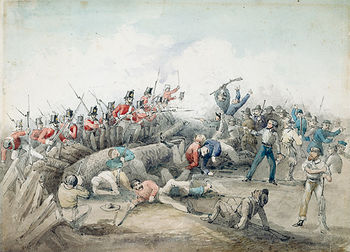
Civil disobedience in Ballarat led to Australia's first and only armed civil uprising, the Eureka Rebellion (colloquially referred to as the Eureka Stockade) which took place in Ballarat on 3 December 1854. The event, in which 22 miners died, is considered to be a defining moment in Australian history.
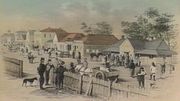
During the 1860s Ballarat prospered on gold mining. Confidence of the city's early citizens in the enduring future of their city is evident in the sheer scale of many of the early public buildings, generous public recreational spaces, and opulence of many of its commercial establishments and private housing. The railway came to the town with the opening of the Geelong-Ballarat line in 1862,[16] As Ballarat grew, the region's original indigenous inhabitants were quickly expelled to the fringe and by 1867 few at all remained.[12]
1870s: A city emerges
Ballarat was proclaimed a city in 1871. During the period from the 1880s to the early 20th century Ballarat made a successful transition from a gold rush town to industrial age city. A direct railway to Melbourne was completed in December 1889.[17] Many industries and workshops that had been established as a result of manufacturing and servicing for the deep lead mining industry.

During 1901, the Duke of Cornwall and York, later King George V and Duchess journeyed by train on 13 May from Melbourne to Ballarat .[18]
Turn of the 20th Century and Decline
Following the turn of the century Ballarat's growth had all but stopped. World War I dented the city's population further and the general decline led to the gradual loss of first provincial status to Geelong.[19] In response, local lobbyists continually pushed the Victorian government for decentralisation, the greatest success being the Victorian Railways opening the Ballarat North Workshops in April 1917.[20] The Great Depression proved a further setback for Ballarat, with the closure of many institutions.
Postwar Recovery
While deep, the depression was also brief, the interwar period proved a period of recovery for Ballarat with a number of major infrastructure projects well underway including a new sewerage system. In 1930, Ballarat Airport was established. By 1931 Ballarat's economy and population was recovering strongly with further diversification of industry although in 1936 Geelong displaced it as the state's second largest city.[21] During WWII an expanded Ballarat airport was the base of the RAAF Wireless Air Gunners' School as well as the base for USAAF Liberator bomber squadrons.
In the Post-war era, Ballarat's growth continued, expanding significantly to the northwest and an acute housing shortage was eased with the establishment of an extensive Housing Commission of Victoria estate on the former Ballarat Common (today known as Wendouree West).[22] The estate was originally planned to contain over 750 prefabricated houses. Whilst planning for the estate began in 1949, main construction occurred between 1951 to 1962. During the 1970s a further 300 houses were constructed. Private housing in the adjacent suburb of Wendouree closely matched and eventually eclipsed this by the mid 1960s. The suburb of greater Wendouree and Wendouree West had evolved as the suburban middle-class heart of the city.
By the 1970s, Ballarat began to officially recognise its substantial heritage and the first heritage controls were recommended to ensure its preservation. With the opening of Sovereign Hill, the city made a rapid shift to become a major cultural tourist destination.
Contemporary Ballarat
The city continued to grow at the national average throughout the late 20th Century and early 21st Century. In 2008 the City Council released a plan directing that growth of the city over the next 30 years is to be concentrated to the west of the city centre and through the redevelopment of inner city housing blocks, and other under-developed inner-city land in the East that is being redeveloped to create a higher-density housing structure.
Geography
Topography

Ballarat lies at the foothills of the Great Dividing Range in Central Western Victoria. Also known as the Central Highlands, it is named so because of its gentle hills and lack of any significant mountains that are more common in the eastern sections of the Great Dividing Range. The city lies within a gently undulating section of the midland plains which stretch from Creswick in the north, to Rokewood in the south, and from Lal Lal in the south-east to Pittong in the west. These plains are made up of alluvial sediment and volcanic flows, and contain large areas of rich agricultural soils.[23] A large feature of the city is the man-made Lake Wendouree (formerly Yuille’s Swamp), around which many of the inner suburbs are situated. The central city is situated low in the valley of the Yarrowee catchment and surrounded by hills and the skyline is visible only from the hills and the lower lying inner eastern suburbs.
There are numerous densely forested areas around Ballarat and large bodies of water including the White Swan Reservoir and other lakes, rivers and creeks which are used for urban water use and agriculture.
There are still thought to be large, undiscovered gold reserves around the Ballarat region, with investigations being made by local and national companies to extract potentially as much gold as the Gold Rush days in the mid 1800s.[24]
Settlement patterns around Ballarat consist of small villages and country towns, some with less than a few thousand people.
Climate
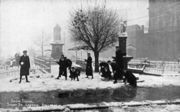
Ballarat has a moderate oceanic climate (Köppen climate classification Cfb)[25][26] with four seasons. Its elevation, at 435 metres (1,427 ft) above sea level, causes its mean monthly temperatures to tend on average 3 – 4 degrees Celsius below those of Melbourne. The mean daily maximum temperature for January is 25.0 °C (76.8 °F) whilst the mean minimum is 10.8 °C (51 °F) In July, the mean maximum is 10.0 °C (50 °F), with average July minimum is 3.2 °C (38 °F).
The mean annual rainfall is 695 millimetres (27.75 in), with August being the wettest month (77 mm/3.0 in). There are an average of 198 rain-free days per year.
In winter, snow typically falls on nearby Mount Buninyong and Mount Warrenheip. Light snowfall in the city occurs once every few winters. Widespread frosts and fog are also common in and around the city during the cooler months.
Ballarat's highest maximum recorded temperature was 44.1 °C (111.4 °F) on 7 February 2009 during the 2009 southeastern Australia heat wave. This is 2.1 °C above the previous record of 42.0 °C , set on 25 January 2003. The city's lowest ever recorded minimum was −6.0 °C (21.2 °F) on 21 July 1982.[27]
In recent years, Ballarat (along with South Eastern Australia) has experienced a severe decrease in average annual rainfall with falls averaging as low as 400 mm (16 in) per year since 2001. This is evident by the recent drying out of Lake Wendouree and substantial water restrictions being imposed on the city and many other regional centres throughout Victoria.
| Climate data for Ballarat Aerodrome (YBLT) since 1908 | |||||||||||||
|---|---|---|---|---|---|---|---|---|---|---|---|---|---|
| Month | Jan | Feb | Mar | Apr | May | Jun | Jul | Aug | Sep | Oct | Nov | Dec | Year |
| Record high °C (°F) | 42.0 (107.6) |
44.1 (111.4) |
37.7 (99.9) |
31.5 (88.7) |
26.1 (79) |
21.6 (70.9) |
19.1 (66.4) |
23.0 (73.4) |
27.9 (82.2) |
33.4 (92.1) |
37.3 (99.1) |
40.6 (105.1) |
44.1 (111.4) |
| Average high °C (°F) | 25.1 (77.2) |
25.0 (77) |
22.2 (72) |
17.6 (63.7) |
13.6 (56.5) |
10.8 (51.4) |
10.0 (50) |
11.4 (52.5) |
13.8 (56.8) |
16.6 (61.9) |
19.6 (67.3) |
22.6 (72.7) |
17.4 (63.3) |
| Average low °C (°F) | 10.8 (51.4) |
11.4 (52.5) |
9.9 (49.8) |
7.4 (45.3) |
5.7 (42.3) |
4.0 (39.2) |
3.2 (37.8) |
3.7 (38.7) |
4.8 (40.6) |
6.2 (43.2) |
7.8 (46) |
9.4 (48.9) |
7.0 (44.6) |
| Record low °C (°F) | 0.7 (33.3) |
-1.4 (29.5) |
-0.6 (30.9) |
-4.1 (24.6) |
-4.5 (23.9) |
-4.6 (23.7) |
-6.0 (21.2) |
-5.0 (23) |
-4.5 (23.9) |
-3.6 (25.5) |
-1.0 (30.2) |
-1.0 (30.2) |
-6.0 (21.2) |
| Precipitation mm (inches) | 38.1 (1.5) |
43.2 (1.701) |
42.3 (1.665) |
51.7 (2.035) |
65.1 (2.563) |
63.2 (2.488) |
66.5 (2.618) |
74.5 (2.933) |
71.7 (2.823) |
67.1 (2.642) |
55.8 (2.197) |
51.3 (2.02) |
690.9 (27.201) |
| Avg. rainy days | 7.7 | 7.2 | 9.5 | 12.5 | 16.1 | 17.8 | 19.9 | 19.5 | 16.7 | 15.5 | 12.8 | 11.0 | 166.2 |
| Source: [28] | |||||||||||||
Extreme weather events
In 1869 a serious flood of the Yarrowee River put most of the lower section of the city including Bridge and Grenville Street underwater.
Between 1905 and 1907, Ballarat experienced a series of winter snowstorms which blanketed the city with snow. In 1909, Ballarat recorded its wettest month with 167.1mm[29] as well as the highest 24hr rainfall record of 72.1mm.
Prolonged drought caused Lake Wendouree in 2006 and 2007 to dry up completely for the first time in its history.
Snowfalls have occurred in urban Ballarat in November 2006 (light);[30] July 2007 (moderate);[31][32] June 2008 (light)[33] and August 2008 (light).[34]
The city recorded its hottest day on record, when the temperature reached 44.1 °C (111.4 °F) on 7 February 2009 during the 2009 southeastern Australia heat wave, beating the previous record by 2.1 °C
Urban structure
Central business district

The Central Business District (located in Ballarat Central) is a large mixed use office and retail district. Ballarat's CBD (along Lydiard, Sturt Streets, Armstrong, Doveton and Dana Streets) along with the historic centre of East Ballarat – Main Street and Bakery Hill has retained stands of commercial and civic buildings of state and national heritage significance. The CBD area is bounded to the north by railway lines, extends to the west to Drummond Street, to the south to Grant street and to the east as far as Princes Street spanning the floodplain of the Yarrowee River.
Retail
Ballarat's main pedestrian mall is Bridge Mall which occupies a section of Bridge Street between Grenville Street and Humffray Street. The largest indoor shopping mall is Central Square Shopping Centre (built 1988) opposite the town hall which includes the major department stores of Myer and Target. Other shopping malls in the CBD include Norwich Plaza built in the 1970s and the City Arcade built in the 1980s. In the CBD there are several supermarkets including two Coles, a Woolworths, an Aldi and a Big W as well as large specialty stores including The Good Guys, JB Hi-Fi, Dick Smith Electronics and branches of the big four retail banks. Bridge Mall, Sturt Street, Armstrong and Mair Street are the major retail streets in the CBD.
Planning
The Ballarat City Council has begun drafting a Central Business District Strategy for the development of buildings, development sites, transport and streescape for the next 20 – 25 years. As part of the proposal it aims to secure funding and private and government interest in the ongoing development of Ballarat's CBD. The draft proposal identifies Mair Street as an alternate East-West traffic route with the potential for hi-rise mixed use development and possibilities for the creation of a 'Civic Heart' for the city where public events can be conducted on a regular basis.[35]
Skyline
Ballarat's is a primarily low-rise city though apart from the area around Ballarat Airport there are few established height limits for buildings. The tallest building in urban Ballarat at 35 metres, the former Joe White Malting silos located on Gregory Street in suburban Lake Wendouree, were to be converted into apartments[36] however are now to be demolished.[37] The tallest buildings in the central city area is the seven storey Henry Bolte wing of the Ballarat Base Hospital (1994). The Law Court tower (1941) (now Arts Academy) on Camp Street and two MLC office buildings (1957) on Lydiard Street are the next tallest and at five storeys.
Suburbs

Beyond the central area urban Ballarat extends into several suburban areas.
The inner established suburbs were initially laid out around the key mining areas and include Ballarat East, Bakery Hill, Golden Point, Soldiers Hill, Black Hill, Brown Hill, Eureka, Canadian, Mount Pleasant, Redan, Sebastopol and Newington.
The post gold rush era has seen a boom in expansion suburbs extending the conurbation north, south and west. To the west, Ballarat has expanded to Alfredton, Delacombe and Wendouree to the north it has expanded to Ballarat North, Nerrina, Invermay and Invermay Park; and south to Sebastopol, Mount Clear, Mount Helen and more recently merged with the large town of Bunninyong.
Greater Ballarat has some semi-rural suburbs of 2-acre (8,100 m2) to 20-acre (81,000 m2) blocks within 15 minutes of the CBD that are very popular with families which include Miners Rest and Bunkers Hill.
Wendouree is currently the only major suburban activity centre with a large indoor shopping mall – Stockland Shopping Centre (expanded in 2007[38]) and also has a number of surrounding retail parks including a strip shopping centre along Howitt Street including the large retail chain Harvey Norman. Elsewhere are small suburban hubs with supermarkets such as IGA (supermarkets) and small stretches of shopfronts.
Unlike Melbourne, Ballarat does not have a defined urban growth boundary.[39] This has put continuing pressure on the city council to approve development applications for subdivisions outside of the city fringe. In response to lobbying by landholders the Ballarat West Growth Area Plan, a major Greenfield land development plan was prepared and has approved by the city and state government to allow for planned fringe communities consisting of 14,000 new homes and up to 40,000 new residents effectively doubling the city's urban area by extending the urban sprawl from Sebastopol, Delacombe and Alfredton to Bonshaw, Smythes Creek and Cardigan[40][41] with new activity centres to be developed at Delacombe and Alfredton.
Heritage
Ballarat is renowned for its cultural heritage and decorative arts, especially applied to the built environment, combined with the gold rush, this has created a picturesque urban landscape. In 2003 Ballarat was the first of two Australian cities to be registered as a member of the International League of Historical Cities and in 2006 hosted the 10th World League of Historical Cities Congress.
Many of its features demonstrate the breadth and depth of Ballarat's Heritage,[42] which are celebrated during heritage weekend in May.[43]
Avenues and boulevards

Ballarat is notable for its very wide boulevards. The main street is Sturt Street and is considered among one of the finest main avenues in Australia with over 2 kilometres of central gardens known as the Sturt Street Gardens featuring bandstands, fountains, statues, monuments, memorials and lampposts.
Ballarat is home to the largest of a collection of several Avenues of Honour in Victoria. The fifteen kilometre (9.3 mi) long Ballarat Avenue of Honour consists of a total of approximately 4,000 trees, mostly deciduous which in many parts arch completely over the road. Each tree has a bronze plaque dedicated to a soldier from the Ballarat region who enlisted during World War I. The Avenue of Honour and the Arch of Victory are on the Victorian Heritage Register and are seen by approximately 20,000 visitors each year.
Statues and monuments
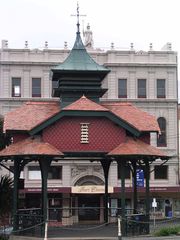
The city also has the greatest concentration of public statuary in any Australian city with many parks and streets featuring sculptures and statues dating from the 1860s to the present day.
Some of the other unique memorials located in the Sturt Street Gardens in the middle of Ballarat's main boulevard include a bandstand situated in the heart of the city that was funded and built by the City of Ballarat Band in 1913 as a tribute to the bandsmen of the RMS Titanic, a fountain dedicated to the early explorers Burke and Wills, and those dedicated to Monarchs and those who have played pivotal roles in the development of the city and its rich social fabric. The most recent memorial is dedicated to a war hero Sir Albert Ernest Coates. Sir Albert Ernest Coates was a soldier and a surgeon born at Mount Pleasant in Ballarat who served as a medical orderly at Gallipoli, trained as a doctor on his return and was worked tirelessly with minimal resources to save countless lives in Prisoner of War camps during World War II.[44]
War memorials
Ballarat has an extensive array of significant war memorials, the most recent of which is the Australian Ex Prisoner of War Memorial. The most prominent memorial in the city is the Ballarat Victory Arch that spans the old Western Highway on the Western approaches of the city. The archway serves as the focal point for the Avenue of Honour. Other significant individual monuments located along Sturt Street include those dedicated to the Boer War (1899–1901), the World War II (1939–1945) cenotaph, and Vietnam (1962–1972) (located adjacent to the Arch of Victory).
Parks and gardens
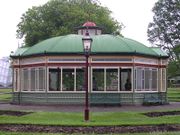
The Ballarat Botanical Gardens (established in 1858) are recognised as the finest example of a regional botanical gardens in Australia and are home to many heritage listed exotic tree species and feature a modern glasshouse and horticultural centre and the Prime Minister's Avenue which features bronze busts of every Australian Prime Minister. The gardens are home to the annual Ballarat Begonia Festival.
Lake Wendouree is a large recreational lake that was created out of former wetlands and hosted the rowing events for the 1956 Summer Olympics.
Victoria Park is an expansive reserve with tree lined avenues and sporting fields in suburban Newington.
The suburbs feature some privately run wildlife parks including Ballarat Wildlife Park in Ballarat East and Ballarat Bird World in Buninyong.
Commercial and civic buildings
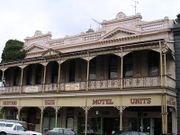
The legacy of the wealth generated during Ballarat's gold boom is still visible in a large number of fine stone buildings in and around the city, especially in the Lydiard Street area. This precinct contains some of Victoria's finest examples of Victorian era buildings, many of which are on the Victorian Heritage Register or classified by the National Trust of Australia.
Notable civic buildings include the Town Hall (1870–72), the former Post Office (1864), the Ballarat Fine Art Gallery (1887), the Mechanics' Institute (1860, 1869), the Queen Victoria Wards of the Ballarat Base Hospital (1890s), and the Ballarat railway station (1862, 1877, 1888). Other fine buildings include the Provincial Hotel (1909), Reid's Coffee Palace (1886), Craig's Royal Hotel (1862–1890) and Her Majesty's Theatre (1875) the oldest intact and operating lyric theatre in Australia.[8]
The Ballarat Fire station located near Bakery Hill, is one of Victoria's oldest fire fighting structures; operated by the Ballarat East brigade – it currently only houses fire trucks. The building was designed in 1864 by architect Henry Caselli as brick masonry; with the construction completed in 1911. Heritage Victoria described the buildings as unusual and sophisticated.[45] Ballarat is also home to the oldest Jewish synagogue on mainland Australia which is located in Bakery Hill in the Ballarat CBD. The first stone was laid on 25 January 1861, during the Victorian Gold Rush period.[46]
Preservation and restoration
Restoration is encouraged including a low interest council Heritage Loans Scheme.[47] and the prevention of demolition by neglect discouraged by council policies.[48] Since the 1970s,[49] the local council has become increasingly aware of the economic and social value of heritage preservation.[50] This is in stark contrast to the 1950s and 60s when Ballarat followed Melbourne in encouraging the removal of Victorian buildings, verandahs in particular. Recent restoration projects funded by the Ballarat include the reconstruction of significant cast iron lace verandahs including the Mining Exchange, Art Gallery (2007), Mechanics institute (2005–)[51] on Lydiard Street and in 2010 the restoration of the Town Hall and the long neglected Unicorn Hotel facade on Sturt Street.[52]
Ballarat Citizens for Thoughtful Development formed in 1998 and was incorporated as Ballarat Heritage Watch in 2005 to ensure that the city's architectural heritage is given due consideration in the planning process.[53]
Environment
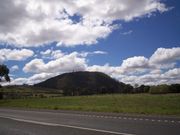
Ballarat has a healthy environment in comparison to Melbourne, however as a growing regional city there are issues including pollution, waterway health and invasive species. Air quality is generally good[54] however woodsmoke from fireplaces is a issue in the winter months.[55] Ballarat's waterways have historically been effected by heavy pollution from both mining and industry.[56][57] Introduced species which are a particular pest include the Brown rat, early infestations of which helped the city to earn the nickname "The Rat". Feral Pigeons are also a problem in Ballarat.
The Ballarat Environment Network formed in 1993 to provide a voice for environmental and nature conservation issues in Ballarat and surrounds.[58] Another large lobby group for sustainability in the city is the Ballarat Renewable Energy And Zero Emissions – BREAZE formed in 2006.[59] The City of Ballarat released an Environment Sustainability Strategy for the city in 2007.[60]
While there are no national parks in Ballarat's proximity, Ballarat is bordered by extensive bushland to the north, south and south west and sensitive wetlands to the east. There are a number of nearby state parks and large reserves including the Enfield State Park, Creswick Regional Park, Mount Warrenheip Flora Reserve Mount Buninyong Reserve and Lake Burrumbeet park. The region is home to a large koala population with protected areas established in the city's outer southern and eastern settlements.[61][62]
Many parts of urban Ballarat have been effected by the introduction of exotic species, particularly introduced flora. Common Gorse is one such problem which has prompted the formation of an official Ballarat Region Gorse Task Force in 1999 to control.[63]
Economy
Ballarat's major industries include the service industries, tourism and hospitality, manufacturing, education and information technology as well as primary industries including agriculture and mining.
As a major service centre for the populous goldfields region, Ballarat has large sectors of employment in retailing, service industries, state and federal government branch offices and agencies and health care.
Tourism and hospitality
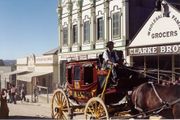
Ballarat attracts 2.2 million visitors a year[64] and the tourism and hospitality industry is a AUD$480 million a year sector which accounts for around 15% of Ballarat's economy and employs around 2,870 people.[65]
A significant heritage tourism industry has grown substantially in Ballarat since the 1960s. Ballarat is most notable for the award-winning open-air museum known as Sovereign Hill, a recreated 1850s gold mining settlement opened in 1970. Sovereign Hill is Ballarat's biggest tourism drawcard and is consistently rated amongst one of the best outdoor museums in the world and continues to expand. Sovereign Hill accounts for over half a million of Ballarat's visitors and $40 million in tourism revenue.[66]
Several tourist traps and spin-offs have capitalised on Sovereign Hill's tourism popularity, most of these have sprung up near the eastern entrance of the Western Freeway between Melbourne and Ballarat. They include Kryal Castle (1972), "Gold Rush Mini Golf" (2002) featuring the "Big Miner" (2006) one of Australia's big things (although the original proposal appeared larger and for the miner to hold the Eureka Flag)[67] at Ballarat's eastern entrance.
Other tourist attractions include the Eureka Centre; The Gold Museum; Ballarat Botanic gardens and Lake Wendouree; the Tramway museum and Ballarat Ghost Tours. A large number of Ballarat hotels, motels and restaurants service the tourism industry. The Ballarat Tourist Association is an industry based non-profit, membership organisation representing the city's tourism industry.
Mining and gold
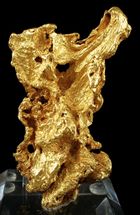
Gold historically has been one of the main industries of the Ballarat region.[68] Gold mining has continued to the present date with a main mine operating and large deposits remaining deep underground. Lihir Gold invested in Ballarat Goldfields in 2006[69] however downscaled its operations in 2009 due to the expense of extraction[70] before selling its stake in 2010 to Castlemaine Goldfields.[71]
Lignite (coal), kaolin (clay) and iron ore have also been mined in the Ballarat region and nearby Lal Lal however many of the resource deposits have since been exhausted.
Manufacturing
According to the 2006 Australian Census, manufacturing is Ballarat's third largest employment sector, accounting for 14.8% of all workers.[72]
Ballarat attracts investment from several international manufacturers. The Australian headquarters of Mars, Incorporated was established in Ballarat in 1979 with the main Ballarat factory producing Mars bars for the Australian market.[73] McCain Foods Limited Australian headquarters was established in Ballarat in 1970 and the company continues to expand its operations.[74] The Ballarat North Workshops is a major manufacturer of public transportation products with current investment from Alstom.[75]
Ballarat also has a large number of home grown companies producing textiles, general industrial engineering, food products, brick and tiles, building components, prefabricated housing components and automotive components.
Education
Ballarat has become a major education centre with the formation of the University of Ballarat which exports education through a large international students program and throughout Australia through distance education programs.
Information technology
In recent years, a large technology park, the University of Ballarat Technology Park with communications centre has been established, with tenants including IBM and employing over 1,400 people.[76]
Agriculture
The outskirts of Ballarat are used for agriculture including wine growing and sheep farming. The Ballarat Livestock Selling Centre is the largest cattle exchange in regional Victoria.[77][78] The Ballarat Agricultural and Pastoral Society formed in 1866 and has run the Ballarat Show annually each November at the Ballarat Showgrounds since that time.[79]
There are also a number of small forestry operations in Ballarat's Canadian Valley around the suburbs of Mt Clear and Mt Helen areas with pine plantations and mills.[80]
Demographics
The 2006 Australian national census indicated that the permanent population of the City of Ballarat was 85,196.[81] Of this the urban population was measured to be 78,221.[82] Although surging land and house prices in Melbourne coupled with significant recent public transport upgrades between Melbourne and Ballarat has witnessed a significant growth surge. Ballarat's abundance of affordable land and highly established infrastructure have caught the notice of many people and families seeking a family friendly lifestyle. Since 2006 Ballarat has averaged an annual population growth of 1700 and in June 2008 had an estimated resident population of 91,787.[83] In August 2009 the estimated resident population was 94,000.
Whilst most of the city's population can trace their ethnic roots to Anglo-Celtic decendency, 13.6% of the population are born overseas, with New Zealand, Germany, the Netherlands and Italy the most common places of birth outside Australia. More recently the city has welcomed new arrivals from the Asian sub-continent and Africa.
Almost 15% of the population is over the age of 65, with over a quarter of the population expected to be over the age of 65 by 2021. The median age in Ballarat is 36 years. 46.8% of the population are married, with almost 35% of the population having never been married.[84]
The average income of Ballarat, while lower than Melbourne, is higher than average for regional Victoria. Ballaratians in the 2007/08 financial year earned on average AUD $38,850 a year[85] with the highest earners living in the city's inner and northern suburbs and the lowers earners living in the city's southern suburbs.
There were 31,959 households in the 2006 census, with 56.5% of the population having access to the internet at home.[86]
Religion
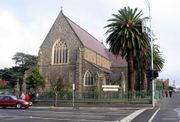
Christianity remains the dominant religion in Ballarat, with over 65% of residents claiming Christian affiliation, slightly above the national average of 64%. Catholics (27.1%), Anglicans (15.0%), Uniting Church (11.2%) and Presbyterians (4.0%) remain the largest Christian denominations in Ballarat.
Over 21.6% of Ballarat residents claim no religious affiliation. Minority religious groups include Buddhism, Judaism and Islam and total less than 5% of the population.
Educational attainment
42.5% of the population have completed further education after high school, with only 11.1% of the population holding a bachelor degree or greater, well below the national average.
Governance
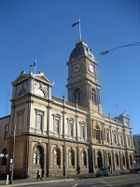
In local government, the Ballarat region is covered by the City of Ballarat. The council was created in 1994 as an amalgamation of a number of other municipalities in the region with the council chambers located at the Ballarat Town Hall in central Ballarat. The City is made up of 3 wards, each represented by three councillors elected once every four years by postal voting.[87] The Mayor of Ballarat is elected from these councillors by their colleagues for a one year term.
In state politics, Ballarat is located in the Legislative Assembly districts of Ballarat East and Ballarat West, with both of these seats currently held by the Australian Labor Party.[88]
In federal politics, Ballarat is located in a single House of Representatives division – the Division of Ballarat. The Division of Ballarat has been a safe Australian Labor Party seat since 2001,[89] and was the seat of the second Prime Minister of Australia, Alfred Deakin.
Media
Newspapers
Ballarat has two local newspapers, both owned by Rural Press Limited, The Courier is a daily, and the Ballarat News, a free weekly. The latter is distributed almost universally across the city every Wednesday, and containing news of community events, advertisements for local businesses, and a real estate and classifieds section.
Radio stations
Local radio stations include '3BA', 'Power FM' and also several community radio stations. There are also local branches of ABC-run ABC Radio, Triple J and ABC Classic FM.
- 102.3 FM – 3BA (local "classic hits" commercial radio station)
- 103.1 FM – Power FM 103.1 FM (local "top-40" commercial radio station)
- 99.9 FM – Voice FM 99.9 – formerly known as 3BBB (local community radio station)
- 107.1 FM – Triple J (ABC Youth Radio)
- 107.9 FM – ABC Local Radio (Government-funded local news, current affairs, light entertainment and talkback)
- 621 AM – ABC Radio National (Government-funded, current affairs, arts, science, social interest)
- 105.5 FM – ABC Classic FM (Government-funded, classical music station)
- 103.9 FM – Good News Radio 103.9 (Christian community-based religious station)
Television
Television station BTV Channel 6 Ballarat commenced transmission of test patterns on 17 March 1962. Among the many local programs BTV6 produced, the 90 minute live variety program "Six Tonight" (1971–1983) hosted by local Ballarat identity Fred Fargher, was one of the few live Australian programs of this type being presented in Australia.
In his 1999 book And Now Here's... (Four Decades of Behind the Scenes Fun in Australian Television), Mike McColl Jones fondly remembers local live television variety. "...and in Ballarat, Victoria, a Tonight show ("Six Tonight") was carving its name into Australian television history. The show, hosted by Fred Fargher, ran for 13 years, and managed to attract many of the top name entertainers in the world, simply by offering them a limo ride to this beautiful country centre, a no-pressure spot on the show, and then a great dinner afterwards at one of the city's excellent restaurants. The sheer bravado of the offer enticed some of show business' biggest names."
Today Ballarat is serviced by numerous 'free to air' High Definition and Standard Definition Digital television services. Two television broadcasting stations are located in the city including WIN, GEM HD and GO! (sub-licensees of Nine Network) and PRIME, 7Two on Prime, 7mate on Prime (a sub-licensee of Seven Network). These two stations broadcast relayed services throughout regional Victoria. The city also receives Southern Cross Ten and One HD (sub-licensee's of Network Ten) that is based in Bendigo but operates a local office. Ballarat television maintains a similar schedule to the national television network but maintains local demographic commercials and local/regional news and some other local/regional programming. In addition to commercial television services, Ballarat receives Government ABC (ABC1, ABC2, ABC3, ABC News 24) and SBS (SBS One and Two) television services.
Subscription television services are provided by Neighbourhood Cable, Austar, and SelecTV.
Education
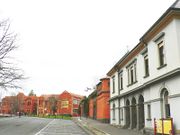
Ballarat is home to two universities – the University of Ballarat and the Ballarat campus of Australian Catholic University.
The University of Ballarat originated as the Ballarat School of Mines, founded in 1870 and once affiliated with the University of Melbourne. The university consists of six campuses, three of which are in Ballarat—two in the city (Camp Street and SMB campuses), and the main campus in Mount Helen, approximately 6 kilometres (3.75 mi) southeast of the city at the foot of Mount Buninyong.
The Australian Catholic University's Ballarat campus began life as the Aquinas Training College run by the Ballarat East Sisters of Mercy in 1909. It is ACU's only rural campus that is located outside of a capital ciy in Australia.
Ballarat has four State Government-operated secondary schools, of which Ballarat High School (established in 1907) is the oldest. The other schools are Sebastopol College, Mount Clear College, and Ballarat Secondary College. Ballarat Secondary College was formed in 1994 by the amalgamation of Ballarat East Secondary College, Wendouree Secondary College and Midlands Secondary College.
Ballarat has two private day and boarding schools which provide education from Years 1 to 12; Ballarat and Clarendon College and Ballarat and Queens Anglican Grammar School.
The city is well serviced by Catholic schools, with 8 primary schools and 3 secondary colleges, the all-boys St Patrick's College, the all-girls Loreto College, and the co-educational Damascus College, which was formed by the amalgamation of St Paul's Technical School and Sacred Heart College in the 1990s.
Ballarat has several public libraries, the largest and most extensive of which is the City of Ballarat Library, run by the Central Highlands Regional Library Corporation and located on Creswick Road. Another library service is provided by the Mechanics' Institute in Sturt Street, which contains an excellent collection of historic, archival and rare reference material.
Arts and culture
Events and Festivals

Ballarat is home to many annual festivals and events. The oldest large annual event is the Ballarat Agricultural Show (since 1859) is currently held each year at the Ballarat Showgrounds.
Lake Wendouree is featured in many including the most prominent, the Begonia Festival (since 1953) and it now attracts over 100,000 visitors from around Australia.[90] SpringFest (since 2001) now attracts more than 15,000 people from around Victoria[91][92] and features market stalls and activities around the lake.
Ballarat Heritage Weekend (since 2006) celebrates the city's heritage with activities such as historic vehicles and displays in and around the CBD and also attracts visitors from around Victoria.[93] Other minor cultural festivals include the Ballarat Writers Festival, Ballarat International Foto Bienialle and the Goldfields Music Festival.
Performing arts
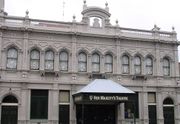
Ballarat has a lively and well established theatrical community with several local ensembles as well as a number of large performing arts venues. Major performing arts venues include:
- Her Majesty's Theatre – Seating 940
- Post Office Box Theatre (University of Ballarat Arts Academy, Camp Street Campus) – Flexible Seating up to 100
- Helen Macpherson Smith Performing Arts Theatre (University of Ballarat, Arts Academy Camp Street Campus) – Seating 200
- The 1870 Founders Theatre (University of Ballarat, Mount Helen Campus) – Seating 600
- The Courthouse Theatre (University of Ballarat, SMB Campus) – Seating 140
- The Victoria Theatre (Sovereign Hill) – Seating 300
- Wendouree Centre for Performing Arts (Ballarat Grammar School) – Seating 900
- Gay E. Gough Theatre (Mount Clear Secondary College) – Seating 350
Additionally the Mechanics Institute hall (seating 700) is used from time to time for travelling performances and cinema shows.
The Ballarat Civic Hall is a large public building constructed in 1958 as a general purpose venue. Its stripped classical design was heavily criticised during its planning, however it has gained some cultural significance to the city with its cavernous spaces holding many significant events over the years. Civic Hall was closed in 2002 and there have been moves to redevelop it for many years[94] with some calls to retain the building as a venue.
Some notable theatre organisations in Ballarat include BLOC (Ballarat Light Opera Company) founded in 1959[95]
Ballarat is also the home to Australia's oldest and largest annual performing arts eisteddfod. The Royal South Street Eisteddfod is an all-encompassing performing arts festival and competition event that is conducted over twelve weeks annually.[96]
Galleries
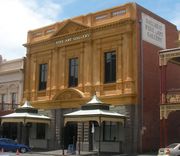
The Ballarat Fine Art Gallery houses one of Australia's oldest and most extensive collections of early Australian works. It is considered to have the best Australian collection outside any capital city in Australia.
The University of Ballarat operates the Post Office Gallery in the Wardell designed former Post Office on the corner of Sturt and Lydiard Streets.[97]
Entertainment and nightlife

In the 1970s the Ballarat urban area contained no less than 60 hotels. The introduction of gaming machines in the early 1990s has brought about significant change in the city entertainment precincts. By 2006 at least 20 hotels had closed and some of those that remain have been redeveloped as dining and/or gaming venues. Gaming machines have brought significant revenue to the remaining hotels, sports and social clubs which has enabled many to expand and modernise.
The city has several dance clubs as well as a highly active live music and jazz scene. Hotels are popular meeting places for young people. The city has many fine restaurants, wine bars and eateries as well as themed restaurants . December 2006 saw the creation of BTR, an organisation within Ballarat that has begun hosting dance events in Ballarat.
A large cinema complex consisting of several theatres is located behind the facade of the old Regent cinemas in the heart of the city.
Dance parties are popular within the Ballarat area; however, the director of Ballarat Health Services (BHS), Andrew Rowe, has stated that Ballarat is "an inappropriate place to hold a rave" and has called for the Moorabool Shire Council to forbid raves (such as the one held at Kryal Castle) around the immediate Ballarat area.[98]
Sport

Ballarat has a number of large parks, sport fields, organised sporting clubs and associations. Australian rules football and cricket are the most popular spectator and participation sports in Ballarat, while basketball, netball, horse racing and rowing have large followings. There are stadiums, both indoor and outdoor as well as training facilities for most sports.
Australian rules football is played at semi-professional and amateur levels with a large number of players at numerous venues, both dedicated such as Eureka Stadium and shared with cricket. The North Ballarat Roosters based out of Eureka Stadium compete in the Victorian Football League and currently have an affiliation with national Australian Football League (AFL) club the North Melbourne Kangaroos. Plans are currently in progression to upgrade Northern Oval (currently known as Eureka Stadium) for hosting regular AFL pre season matches, with an aim to accommodate seating for 20,000 people.[99] The Ballarat Football League (founded 1893) is a strong regional league of which there are 3 teams (Ballarat, Lake Wendouree and North Ballarat City) from Ballarat. The Ballarat Football Club (founded 1860) remains one of the oldest football clubs in the world. A team from Buninyong competes in the regional Central Highlands Football League.
Cricket is also played extensively with three international standard cricket ovals. Ballarat's Eastern Oval hosted a game in the 1992 Cricket World Cup.
Horse racing and greyhound racing are popular, with dedicated facilities. The Harness Racing centre is considered to be among the best in Australia. The Ballarat Turf Club schedules around 28 race meetings a year including the Ballarat Cup meeting in mid-November.[100] Ballarat Harness Racing Club conducts regular meetings at its racetrack in the city. [101] The Ballarat Greyhound Racing Club holds regular meetings at Sebastopol.[102]
Basketball is played at various levels with the Ballarat Miners and Ballarat Lady Miners who competing in the South East Australian Basketball League and playing out of the WIN Minerdome. The venue hosted basketball games for the 2006 Commonwealth Games. Netball is similarly popular, with many netball clubs affiliated with local Australian rules clubs including Wendouree, East Point, Eureka, North Ballarat, Redan, Brown Hill and a the Ballarat Netball Association.
Rowing and kayaking is centred around Lake Wendouree and the sport is particularly popular with the schools. The lake hosts the Victorian Schools Rowing Championships as well as the annual 'Head of the Lake' rowing regatta - contested by Ballarat High School, Ballarat and Clarendon College, Ballarat Grammar School, St Patrick's College and Loreto College. The city hosted rowing events for the 1956 Olympic Games.
Association Football (known locally as soccer) is played mostly at an amateur level, with a competition known as the Ballarat District Soccer Association (BDSA). The Ballarat Red Devils play in the FFV State League division Two North-West.
Athletics facilities include an international standard athletics track at Llanberris Reserve on York Street Golden Point which is an Athletics Victoria venue and home to local athletics and little athletics clubs.
Swimming and water sport is facilitated at two Olympic sized pools as well as an indoor 25 metre (82 ft) competition short course pool. The main facility is the Ballarat Aquatic Centre located at Gillies Street Lake Gardens in the city's west.
Baseball was first organised in Australia at Ballarat in 1857.[103] The Ballarat Brewers field three teams in the Geelong Baseball Association Winter Division, A Grade, A Reserve and C Grade.
Golf is played at four main venues which include the Ballarat Golf Course on Sturt Street in the Easter suburb of Alfredton, home to the Ballarat Golf Club;[104] the Midlands Golf Course on Heinz Lane in the northern suburb of Invermay Park which is home to the Midlands Golf Club;[105] the Eureka Golf Course at Elford Street in the eastern suburb of Ballarat East and in the southern suburb of Buninyong at the Buninyong Golf Course.
In popular culture
Ballarat has inspired many visual artists, with several celebrated works depicting the city. In the Australian Collection of the Ballarat Art Gallery are some of Eugene von Guerard's works documenting the city's establishment as a gold digging settlement, Albert Henry Fullwood's depictions of boom era streetscapes and Knut Bull's View of Ballarat Across Lake Wendouree.[106] Several other artists have painted depictions of historic events such as the Eureka Stockade.
Historic Lydiard Street features prominently in national television advertisement advertisements including the Gold Lion award (Cannes Lions International Advertising Festival)[107] and Australasian Writers and Art Directors Association award winning "The Regulars" (2009) for Victoria Bitter[108] and "What About Me" (2010) Safe Driver Rewards campaign for AAMI.[109]
Ballarat is also a popular filming location[110] with the city making cameos in film including My Brother Jack (2001), Ned Kelly (2003 film) and The Writer (2005).[111]
Ballarat also features prominently in literature and fiction, including the King Billy of Ballarat and Other Stories (1892) by Morley Roberts, The Fortunes of Richard Mahony (1917) by Henry Handel Richardson, Murder on the Ballarat Train (1993) by Kerry Greenwood and The Supply Party by Martin Edward (2009).
The town of Ballarat, California is named after Ballarat.
Two ships of the Royal Australian Navy have been named HMAS Ballarat after the city, HMAS Ballarat (J184) and HMAS Ballarat (FFH 155).
Infrastructure
Health
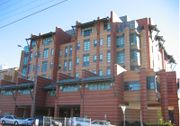
Ballarat has major hospitals in Ballarat Base Hospital which services the entire region and the Queen Elizabeth Centre. Private hospitals include a St John of God Health Care centre, established in 1915 and is currently the largest private hospital in regional Victoria.
Utilities
Central Highlands Water supplies Ballarat with water. The main reservoir is the White Swan reservoir which is topped up through the Goldfields Superpipe sourced from the Goulburn-Murray waterway system. Secondary supplies include the Gong Gong Reservoir.[112]
Ballarat's data communications services now come from several providers, however for a long time the city went without broadband services. An extensive private broadband network was built by Neighbourhood Cable, now Telstra and Optus also provide broadband services. No announcement of Ballarat's rollout of the National Broadband Network has yet been made however it is seen as vital for the city's growing IT industry.[113][114]
Ballarat's residential electricity comes from the National Electricity Market with the main retailer is Powercor with a number of smaller suppliers also servicing the region. The Ballarat region produces more than enough wind energy to power ever home in the city, however the electricity produced goes to the grid, with the Waubra Wind Farm and another facility, the Mount Mercer Wind Farm has also been approved.[115]
Transport
Road
The main mode of transport in Ballarat is the road network and the automobile. The dual carriageway freeway – the Western Freeway connects Ballarat to Melbourne (approximately 90 minutes) and also bypasses the city on its way to Ararat (approximately 75 minutes) and Horsham. A network of state highways from Ballarat including the Midland Highway which runs north toward Creswick (approximately 25 minutes) from Creswick Road and south toward Geelong (approximately 87 minutes) from Skipton Road, the Glenelg Highway to Mount Gambier and the Sunraysia Highway near Ballarat which connects the city with Mildura. Sturt Street and Victoria Street, both dual carriageways carry the bulk of the east-west CBD traffic, while Mair Street is planned to become dual carriageway to relieve pressure on these main streets. Other dual carriageway main roads in the west include Howitt Street and Gillies Street. The remainder of Ballarat's roads are mainly secondary single carriageways and service lanes in the inner suburbs.
Ballarat is also served by an extensive public bus service branded as Ballarat Transit which is currently operated mainly by Ballarat Coachlines and Davis Bus Service.[116] The taxi system operates in all suburbs and is currently operated by Ballarat Taxis Co-op Ltd.
Regional coaches operated by V/Line connect Ballarat with other regional centres such as Warrnambool, Bendigo, Mildura and Maryborough. There is also a direct bus service to Melbourne's Tullamarine Airport.[117]
Rail

Ballarat has historically been a major railway hub in Victoria, situated at the junction of the Ballarat line, Ararat line and Mildura lines it currently has several connections for both passenger services and freight.
Ballarat has two passenger railway stations, the hub of Ballarat railway station and suburban Wendouree railway station[118] out of which V/Line operates VLocity trains running at up to 160 km/h (99 mph) east to Melbourne, west and Ararat and north to Maryborough. The busiest service is the peak hour express (64 minutes) to Melbourne which has become highly popular with commuters.[119] The Regional Rail Link project is underway to separate Ballarat's trains from Melbourne's suburban rail network for more regular services.[120] Interurban services (Ballarat-Melbourne) now run half hourly during weekday peak and hourly on weekends from Ballarat station. A twice daily (53 minute) service connects Ballarat to Ararat while there is a (57 minute) service to and from Maryborough (stopping at Creswick) once a day each way.[121]
The Ballarat to Geelong (the Geelong-Ballarat railway line) currently operates as a freight line only (passenger services were withdrawn in 1978) and the city has several disused railway corridors and stations along the Skipton railway, Buninyong railway and the Ballarat Cattle Yards railway.
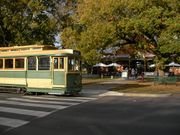
Ballarat once operated an extensive tramway network which began in 1887, however it was closed in 1972 and replaced by buses. A small section of track remains used as a tourist and museum tramway.[122] There have been proposals to extend the network, particularly to connect it to the railways and return it as a viable component of the Ballarat public transport system.[123]
Air
Ballarat Airport located 8 km (5 mi) North-West of the CBD consists of two sealed runways (each approximately 1,400 m/4,600 ft length and 30 m/100 ft wide) as well as extensive sealed aprons, night lighting and NDB Navaid. In 2005 the City of Ballarat commissioned a Master Plan 2004–2014,[124] that outlined future development and growth of the Airport. The report made a series of recommendations and forecasts that included eventual lengthening, widening and strengthening of the existing main runway up to 1800 metres (5,900 ft), consideration for expansion of the passenger terminal and recommendations for future use of aprons and development of future structures supporting larger aircraft and increased frequent usage. It is forecast that by 2012–15 regular domestic passenger services using 40–50 seat commuter aircraft may feasibly commence.
Cycling
Ballarat has a long history of cycling as a form of transport and recreation. The current cycling network continues to grow and consists of several marked on-road routes and 50 kilometres of segregated bicycle facilities including several main routes :Ballarat–Skipton Rail Trail, Yarrowee River Trail with connections to the Gong Gong Reservoir, Buningyong Trail, Sebastopol Trail, and the Lake Wendouree shared path.[125] The Ballarat Bicycle Users Group provides advocacy for the growing number of cyclists in the city.[126] The popularity of cycling in Ballarat is also demonstrated by the large number of spectators and participants drawn to cycling sporting events held in the city.[127]
Notable residents
A great many notable people's origins are in the Ballarat region with the most prominent local celebrities being high ranking politicians and sportspeople.
Several former Prime Minister of Australia were Ballaratians (recognised by the city hosting the Prime Minister's Avenue) – Alfred Deakin, Sir Robert Menzies, James Scullin and John Curtin. Several Premiers of the Australian states are also from Ballarat including Victorian premiers Sir Henry Bolte, Steve Bracks, Duncan Gillies, Thomas Hollway and West Australian premier Henry Daglish.
Outside of politics, other prominent public figures include Peter Lalor an important historical figure in Australia as the leader of the Eureka Rebellion (1854); the inventor George Alfred Julius who spent part of his childhood in the town, his father being the Anglican vicar; Cardinal George Pell, Catholic Archbishop of Sydney.
Ballarat has also produced many outstanding athletes including such sporting greats. Olympic long distance runner Steve Moneghetti is one of the city's favourite sons. A large number of great Australian rules football identities have come from Ballarat, the greatest being Tony Lockett AFL Legend and record holder of most goals scored in a career; Premiership coach Mick Malthouse and Geelong Football Club legend Bob "Woofa" Davis.
Sister cities
The City of Ballarat's sister cities are:
|
References
- ↑ Australian Bureau of Statistics (25 October 2007). "Community Profile Series : Bendigo (Urban Centre/Locality)". 2006 Census of Population and Housing. http://www.censusdata.abs.gov.au/ABSNavigation/prenav/ProductSelect?newproducttype=Community+Profiles&collection=Census&period=2006&areacode=UCL204800&breadcrumb=LP¤taction=201&action=401. Retrieved 23 February 2010.
- ↑ Retrieved on 19 November 2007
- ↑ [Ballarat population growth pips Geelong and Bendigo] by Meg Rayner for The Courier 31 Mar 2010
- ↑ K. T. Livingston, Richard Jordan, Gay Sweely (2001) Becoming Australians: the movement towards federation in Ballarat and the nation p.34. Wakefield Press
- ↑ http://www.ballaratreformleague.org.au/buninyong.htm
- ↑ http://www.nattrust.com.au/trust_register/search_the_register/ballarat_botanic_gardens
- ↑ http://www.cometolifeballarat.com/visit/experience-ballarat/lakes,-parks-and-gardens/ballarat-botanical-gardens.aspx
- ↑ 8.0 8.1 Her Maj: A History of Her Majesty's Theatre, Ballarat by Peter Freund with Val Sarah ISBN 9780975748312.
- ↑ [1]
- ↑ http://monumentaustralia.org.au/themes/conflict/ww1
- ↑ Perkin, Corrie Golden city of Ballarat comes into the picture The Australian September 01, 2009
- ↑ 12.0 12.1 "Ballarat’s Indigenous Heritage". Sovereign Hill Education. http://sheducationcom.ascetinteractive.biz/uploads//SovHill%20indigenousheritage%20notes%20ss1.pdf. Retrieved 19 August 2010.
- ↑ Premier Postal History. "Post Office List". https://www.premierpostal.com/cgi-bin/wsProd.sh/Viewpocdwrapper.p?SortBy=VIC&country=. Retrieved 11 April 2008
- ↑ James, Ken. "The surveying career of William Swan Urquhart, 1845–1864". Public Record Office Victoria. Government of Victoria. http://www.prov.vic.gov.au/provenance/no8/SurveyingCareer1.asp. Retrieved 19 August 2010.
- ↑ pg 11. Jacobs, Wendy. Ballarat: A Guide to Buildings and Areas 1851–1940 Jacob Lewis Vines Conservation Architects and Planners (1981)
- ↑ "Rail Geelong – Geelong Line Guide". www.railgeelong.com. http://www.railgeelong.com/lineguide/geelong. Retrieved 23 April 2008.
- ↑ Sid Brown (March 1990). "Tracks Across the State". Newsrail (Australian Railway Historical Society (Victorian Division)): 71–76.
- ↑ Royal Visit to Ballarat 1901 McLean, Jack Australian Railway Historical Society Bulletin, August 1994 pp211-233
- ↑ Progressive Geelong – Industrial Expansion. Development of the Harbour. The Argus, Melbourne 14 October 1921 p 8
- ↑ Lee, Robert (2007). The Railways of Victoria 1854–2004. Melbourne University Publishing Ltd. p. 144. ISBN 9780522851342.
- ↑ Geelong Ousts Ballarat. Population Surprises. The Argus (Melbourne) Tuesday 28 April 1936, page 10
- ↑ "Wendouree West Profile and History". Wendouree West Community Renewal. http://www.wendoureewest.com/renewal/wendwest.htm#history. Retrieved 19 August 2010.
- ↑ City of Ballarat (Maps, Population & Location – http://www.ballarat.vic.gov.au/Global/Maps/index.aspx)
- ↑ Ballarat Goldfields – http://www.lglgold.com/data/portal/00000005/content/68910001181645144108.pdf
- ↑ Peel, M. C.; B. L. Finlayson, and T. A. McMahon (1 March 2007). "Updated world map of the Köppen-Geiger climate classification". HESSD – Hydrology and Earth system sciences (4): 439–473. http://www.hydrol-earth-syst-sci-discuss.net/4/439/print-redirect.html.
- ↑ Linacre, Edward; Geerts, Bart (1997). Climates and Weather Explained. London: Routledge. p. 379. ISBN 0-415-12519-7. http://books.google.com/?id=mkZa1KLHCAQC&lpg=PA379&pg=PA379#v=onepage&q=.
- ↑ Weatherzone, 2009
- ↑ "Climate statistics for Ballarat". Australian Bureau of Meteorology. http://www.bom.gov.au/climate/averages/tables/cw_089002.shtml. Retrieved 8 February 2009.
- ↑ Nolan, Pat. Ballarat cold snap may bring snow The Courier. 25 Aug 2010
- ↑ "Fires rage and snow's falling". The Sydney Morning Herald. 15 November 2006. http://www.smh.com.au/news/national/fires-rage-and-snows-falling/2006/11/15/1163266590381.html.
- ↑ Burgess, Matthew (July 8, 2008). "Snow falls as cold snap hits state". The Age (Melbourne). http://www.theage.com.au/national/snow-falls-as-cold-snap-hits-state-20080708-38d2.html.
- ↑ "Ballarat snowfall – ABC News (Australian Broadcasting Corporation)". ABC News. http://www.abc.net.au/local/photos/2010/10/18/3041397.htm. Retrieved 18 August 2010.
- ↑ "Snow falls in Ballarat – ABC News (Australian Broadcasting Corporation)". Abc.net.au. 8 July 2008. http://www.abc.net.au/news/photos/2008/07/08/2297589.htm. Retrieved 18 August 2010.
- ↑ Watt, Jarrod (11 August 2008). "Sunday snow in Ballarat – ABC Ballarat – Australian Broadcasting Corporation". Abc.net.au. http://www.abc.net.au/local/photos/2008/08/11/2331555.htm. Retrieved 18 August 2010.
- ↑ Central Business District (CBD) Strategy – http://www.ballarat.vic.gov.au/city-projects-and-strategies/current-projects/central-business-district-strategy.aspx
- ↑ Gray, Darren (20 April 2009). "Disused Ballarat silos to be made into apartments". The Age (Melbourne). http://www.theage.com.au/national/disused-ballarat-silos-to-be-made-into-apartments-20090419-abfs.html.
- ↑ Nolan, Pat Gregory St silos to come down The Courier. 4 Aug 2010
- ↑ http://www.stockland.com.au/assets/shopping-centres_vic/DEV24467_WEN_FlashTower.pdf
- ↑ http://www.dse.vic.gov.au/melbourne2030online/content/policies_initiatives/02a_policy21.html
- ↑ http://www.ballarat.vic.gov.au/media/57489/ballarat%20city%20council%20-%20tract%20expert%20evidence.pdf
- ↑ "Ballarat West Local Structure Plan". Business Ballarat. http://www.businessballarat.com/?id=ballaratwestlocalstr. Retrieved 18 August 2010.
- ↑ Heritage – City of Ballarat
- ↑ Ballarat Heritage Weekend – Home
- ↑ Albert.shtml University of Ballarat Honour Roll.
- ↑ Brown, Jenny (May 2010). "The Tower". Royal Auto (RACV Public Affairs): p. 7.
- ↑ Heritage Victoria – Ballarat Synagogue
- ↑ "Heritage Restoration Loan". Ballarat.vic.gov.au. 1 June 2010. http://www.ballarat.vic.gov.au/heritage/heritage-services-and-resources/heritage-restoration-loan.aspx. Retrieved 18 August 2010.
- ↑ Ballarat City Council Plan to Preserve Heritage by Marcus Power for The Courier. 26 Apr 2010
- ↑ "Heritage Protection". Ballarat.vic.gov.au. 1 June 2010. http://www.ballarat.vic.gov.au/building-and-planning/statutory-planning/heritage-protection.aspx. Retrieved 18 August 2010.
- ↑ The Economics of Heritage – The value of heritage to the City of Ballarat from environment.gov.au
- ↑ "Media Release: BALLAARAT MECHANICS INSTITUTE TO GET $1.5M RESTORATION". Legislation.vic.gov.au. 4 November 2005. http://www.legislation.vic.gov.au/domino/Web_Notes/newmedia.nsf/955cbeae7df9460dca256c8c00152d2b/d9871d74f940d93cca2570b100826472!OpenDocument. Retrieved 18 August 2010.
- ↑ Restoration work to start at Unicorn Hotel after permits approved by Marcus Power for The Courier. 27 Mar 2009
- ↑ "Ballarat Heritage Watch". Ballaratheritagewatch.wordpress.com. http://ballaratheritagewatch.wordpress.com/. Retrieved 18 August 2010.
- ↑ "Airbourne particle monitoring at Ballarat, Feb 02 to Sept 03" (PDF). http://epanote2.epa.vic.gov.au/EPA/Publications.NSF/515bc2fde7bf93f44a2565b6001ee896/83b1f49d9d53c2d0ca256dc700218012/$FILE/936.pdf. Retrieved 18 August 2010.
- ↑ "Air monitoring at Ballarat August 2005 to August 2006". Epanote2.epa.vic.gov.au. http://epanote2.epa.vic.gov.au/EPA/Publications.NSF/PubDocsLU/1111?OpenDocument. Retrieved 18 August 2010.
- ↑ Quinlan, Kim (11 April 2002). "Yarrowee: Don't call it a creek. – Local News – News – News Features". The Courier. http://www.thecourier.com.au/news/local/news/news-features/yarrowee-dont-call-it-a-creek/526254.aspx. Retrieved 18 August 2010.
- ↑ http://epanote2.epa.vic.gov.au/EPA/media.nsf/ad5006bdf5dcd5c84a256695000c4619/fc59cf3423e7e9d04a2566dd0017d972/$FILE/EPA%20Media%20Release.rtf
- ↑ "Offline". BEN. http://www.ben.org.au. Retrieved 18 August 2010.
- ↑ "Welcome to BREAZE". Breaze.org.au. http://www.breaze.org.au/. Retrieved 18 August 2010.
- ↑ http://www.ballarat.vic.gov.au/media/66766/city%20of%20ballarat%20environment%20sustainability%20strategy.pdf
- ↑ http://www.thecourier.com.au/news/local/news/general/vcat-knocks-back-mt-helen-subdivision-due-to-koalas/1902027.aspx
- ↑ http://www.ballarat.vic.gov.au/media/57443/ballarat%20koala%20plan%20of%20management%20-%20information%20brochure.pdf
- ↑ http://www.environment.gov.au/soe/2001/publications/theme-reports/biodiversity/biodiversity04-2a.html#cs18
- ↑ City of Ballarat Visitor Services
- ↑ "Ballarat Tourist Association". Ballarat Tourist Association. http://www.ballarattouristassociation.asn.au/. Retrieved 18 August 2010.
- ↑ Business Ballarat – Sovereign Hill
- ↑ http://www.goldrushgolf.com.au/uploads/GoldrushEditorial_4_web.pdf
- ↑ http://www.lglgold.com/data/portal/00000005/content/35824001175418214937.pdf
- ↑ Lihir Gold to buy Ballarat for $350m by Jamie Freed for The Age. 18 October 2006
- ↑ 200 jobs lost as Lihir Gold quits Ballarat by Mathew Murphy for The Age. 22 July 2009
- ↑ "Lihir Gold sells Ballarat mine to Castlemaine | TopNews". Topnews.in. http://www.topnews.in/lihir-gold-sells-ballarat-mine-castlemaine-2255447. Retrieved 18 August 2010.
- ↑ Ballarat City Council representatives to meet with Federal Minister for Innovation, Industry, Science and Research Thursday, 18 February 2010
- ↑ Sobey, Emily Mars celebrates 30 years in Ballarat The Courier. 24 Nov 2009
- ↑ About McCain
- ↑ X'trapolis Train Manufacturing Under Way in Ballarat
- ↑ "Multimedia Victoria – IBM expansion brings 300 jobs to Ballarat". Mmv.vic.gov.au. 4 December 2009. http://www.mmv.vic.gov.au/NewsIBMexpansionbrings300jobstoBallarat. Retrieved 18 August 2010.
- ↑ http://www.trsn.com.au/SiteFiles/nswtrsncomau/VIC_Ballarat.pdf
- ↑ "Ballarat cattle market improves in tough conditions – State News – Livestock – Cattle – Stock & Land". Sl.farmonline.com.au. 2 March 2009. http://sl.farmonline.com.au/news/state/livestock/cattle/ballarat-cattle-market-improves-in-tough-conditions/1447826.aspx. Retrieved 18 August 2010.
- ↑ "Ballarat Agricultural and Pastoral Society, Ballarat Show". Ballarat.com. http://www.ballarat.com/baps/. Retrieved 18 August 2010.
- ↑ http://www.ballarat.vic.gov.au/media/57458/explanatory%20report.pdf
- ↑ Australian Bureau of Statistics (25 October 2007). "Ballarat (VIC) (Statistical District)". 2006 Census QuickStats. http://www.censusdata.abs.gov.au/ABSNavigation/prenav/LocationSearch?collection=Census&period=2006&areacode=2027&producttype=QuickStats&breadcrumb=PL&action=401. Retrieved 27 September 2007.
- ↑ Australian Bureau of Statistics (25 October 2007). "Ballarat (Urban Centre/Locality)". 2006 Census QuickStats. http://www.censusdata.abs.gov.au/ABSNavigation/prenav/LocationSearch?collection=Census&period=2006&areacode=UCL202600&producttype=QuickStats&breadcrumb=PL&action=401.
- ↑ "3218.0 – Regional Population Growth, Australia, 2007–08". ABS. 23 April 2009. http://www.abs.gov.au/ausstats/[email protected]/Latestproducts/3218.0Main%20Features52007-08?opendocument&tabname=Summary&prodno=3218.0&issue=2007-08&num=&view=.
- ↑ Ballarat East Electorate Statistical Data – http://home.vicnet.net.au/~ghoward/About%20Ballarat%20East%20Electorate.html
- ↑ Nolan, Pat Higher income in central Ballarat The Courier 14 Sep 2010
- ↑ Australian Bureau of Statistics – Ballarat Statistical Region http://www.abs.gov.au/AUSSTATS/[email protected]/Latestproducts/LGA20570Population/People12002-2006?opendocument&tabname=Summary&prodno=LGA20570&issue=2002-2006
- ↑ [Victorian Electoral Commission profile for Ballarat http://www.vec.vic.gov.au/Government/ballaratprofile.html]
- ↑ "State Election 2006 Results: Electorate swings". Victorian Electoral Commission website. Archived from the original on 30 November 2007. http://web.archive.org/web/20071130000929/http://www.vec.vic.gov.au/electorateswing.html. Retrieved 16 December 2007.
- ↑ "Seats won in the 2007 Federal Election". Australian Electoral Commission website. http://results.aec.gov.au/13745/website/HouseSeatsWon-13745-NAT.htm. Retrieved 16 December 2007.
- ↑ BEGONIA FESTIVAL ENTERS NEW ERA WITH BRACKS GOVERNMENT SUPPORT Minister for Tourism. October 15, 2003
- ↑ http://www.ballaratspringfest.com.au/pages.php?page=11
- ↑ Nolon, Patrick SpringFest will go on whatever the weather The Courier 28 Oct, 2010
- ↑ Brown, Emma Heritage Weekend crowds up on last year The Courier. 10 May 2010
- ↑ Marcus Power (7 December 2009). "Civic Hall plan to go before Ballarat City Council – Local News – News – General". The Courier. http://www.thecourier.com.au/news/local/news/general/civic-hall-plan-to-go-before-ballarat-city-council/1698639.aspx. Retrieved 18 August 2010.
- ↑ "About Us". BLOC Music Theatre. http://blocmusictheatre.com.au/content/about-us. Retrieved 18 August 2010.
- ↑ Royal South Street Society
- ↑ UB Site Listing
- ↑ "Three overdose at Daft Punk show". The Age (Melbourne). 14 December 2007. http://www.theage.com.au/news/national/three-overdose-at-daft-punk-show/2007/12/14/1197568259082.html. Retrieved 14 December 2007.
- ↑ The Courier, 2009
- ↑ Country Racing Victoria. "Ballarat Race Club". Archived from the original on July 19, 2008. http://web.archive.org/web/20080719021221/http://countryracing.com.au/index.php?option=com_club_info&club=49&Itemid=80. Retrieved 7 May 2009
- ↑ Australian Harness Racing. "Ballarat". http://www.harness.org.au/ballarat/ballarat.cfm?fromstate=vic. Retrieved 11 May 2009
- ↑ Greyhound Racing Victoria. "Ballarat". Archived from the original on August 22, 2008. http://web.archive.org/web/20080822214133/http://ballarat.grv.org.au/index.html. Retrieved 15 April 2009
- ↑ Harris, John O. (2009). Queensland Baseball 1905–1990. p. 14.
- ↑ Golf Select. "Ballarat". http://www.golfselect.com.au/armchair/courseView.aspx?course_id=258. Retrieved 11 May 2009
- ↑ Golf Select. "Midlands". http://www.golfselect.com.au/armchair/courseView.aspx?course_id=296. Retrieved 11 May 2009
- ↑ http://www.balgal.com/?id=collection
- ↑ Ballarat's big VB ad wins Cannes gong by Erin Williams for The Courier. 27 Jul 2010
- ↑ Foster's hoping to strike VB gold in Ballarat
- ↑ "News :: Film Ballarat Hepburn & Beyond :: An initiative to promote film and television production in regional Victoria, Australia". Filmballarathepburnandbeyond.com.au. http://www.filmballarathepburnandbeyond.com.au/news/index/id/402/year/2010. Retrieved 18 August 2010.
- ↑ "Filmed Here :: Film Ballarat Hepburn & Beyond :: An initiative to promote film and television production in regional Victoria, Australia". Filmballarathepburnandbeyond.com.au. http://www.filmballarathepburnandbeyond.com.au/filming/feature. Retrieved 18 August 2010.
- ↑ [2]
- ↑ Ballarat population growth: water supply critical by Kim Quinlan for The Courier 28 Apr 2010
- ↑ Power, Marcus Broadband revolution coming to Ballarat 13 May 2009
- ↑ http://www.ballaratict.com/resources/Issues-MinisterConroy.pdf
- ↑ Houston, Cameron Ballarat wind farm approved The Age. April 13, 2007
- ↑ "Bus Association Victoria". Busvic.asn.au. http://www.busvic.asn.au/links/content.aspx?id=11. Retrieved 18 August 2010.
- ↑ Airport Shuttlebus
- ↑ Victorian Transport Plan – Ballarat:Wendouree Station http://www4.transport.vic.gov.au/vtp/projects/wendouree.html
- ↑ Regional rail travel booming, despite delays from The Age
- ↑ Victorian Transport Plan – Regional Rail Link http://www4.transport.vic.gov.au/vtp/projects/regionalraillink.html
- ↑ Polkinghorne, David Ballarat-Maryborough day trip a no go, The Courier, 6 Aug 2010
- ↑ Ballarat Tramway Museum
- ↑ Tram plans on track by Mariza Fiamengo for The Courier. 1 May 2001
- ↑ [3]
- ↑ Ballarat City Council Bicycle Strategy 2008
- ↑ Ballarat Bicycle Users Group
- ↑ Cycling boon for Ballarat region David Brehaut for The Courier. 10 May 2010
Bibliography
History books
- Bate, Weston. Lucky City: The First Generation of Ballarat 1851–1901 (1978)
- Bate, Weston. Life After Gold: Twentieth-Century Ballarat Melbourne University Press (1993)
- Carboni, Raffaello. The Eureka Stockade (1980) first published (1855)
- Goodman, David. Gold Seeking: Victorian and California in the 1850s (1994)
- Jacobs, Wendy. Ballarat: A Guide to Buildings and Areas 1851–1940 Jacob Lewis Vines Conservation Architects and Planners (1981)
- Lynch, John. The Story of the Eureka Stockade: Epic Days in the early fifties at Ballarat, (1947?)
- Fleet, James. The History of Gold Discovery in Victoria
- Moloney, John. Eureka, (1984)
- Serle, Geoffery. The Golden Age: A History of the Colony of Victoria, 1851–1860, (1963)
- Freund, P with Sarah V, Her Maj: A History of Her Majesty's Theatre, Ballarat (2007)
- Ballarat City Council
- Victorian Heritage Register, Heritage Victoria
External links
|
|||||
|
||||||||||||||||||||||||||
|
|||||||||||||||||